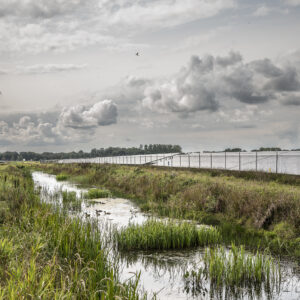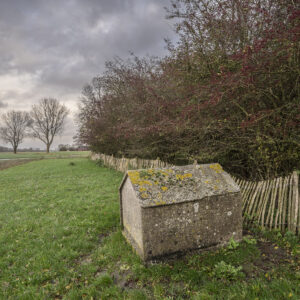Peter Winter and Jan Pieter Kok have been involved in the initiative right from the start. ‘The idea was first brought up as a stray thought during lunch hour’, says Winter, former managing director of the local Tourist Information Office. Shortly before the turn of the Century, Terschelling had organised some successful theme years, attracting many extra visitors to the island. 1994 was the Brandaris year, marking the completion of this well-known lighthouse 400 years ago, two years later followed by the Willem Barentsz year commemorating the death of this Terschelling-born navigator and explorer also 400 years earlier, and finally in 1999 the anniversary of the sinking of the British frigate HMS Lutine off the Frisian coast on October 9th 1799, leaving a treasure of gold bars on the bottom of the sea. On each occasion the programme contained a bicycle tour along certain objects that had not been manufactured on the island, such as miniature lighthouses and glass works of art. ‘So we were not short of experience with routes and route descriptions’, says graphic designer Kok.
The immediate reason for a brainstorming session was an initiative of the Stichting Ons Schellingerland (SOS). The Foundation laboured for the conservation of the typical Terschelling values and was keen to restore two historic and valuable objects. Kok: ‘They appealed to the LEADER coordinator, who advised to combine a number of initiatives, since the project was too small to be considered: a wider tourist perspective would be more successful.
With the possible Leader subsidy in mind, the now developed think-tank elaborated on the basic principle that islanders like the idea of conservation and restoration, and that tourists are interested in the cultural background of Terschelling. And next came a substantial list of valuable elements that deserved attention and maintenance.
Annual inspection
The project plan ‘Footprints in the sand’ subsequently submitted by the committee turned out to be ambitious. The bicycle route has 46 characteristic elements, 19 of which required or still require a facelift, maintenance or restoration. Part of it has already been completed. For instance, the ”Kaap op de Boschplaat” has been renovated and relocated, entirely in line with the demands from SOS. This navigation mark had become dilapidated and was in danger of falling over as the coastline had eroded at this spot. The so-called Sjouw in Hoorn has also been restored into its former glory. This ”time ball” – a wicker basket hanging from a huge pole – used to serve farmers who were at work on the land. If the basket was hoisted up, it was lunchtime or time for milking the cows.
Also as part of the ‘Footprints in the sand’ project, the monument in remembrance of the sinking of the gold ship Lutine has been restored and given a better spot on the bicycle track along the marina of West-Terschelling, near the ‘Willem Barentsz’ Nautical Institute. At the time the memorial was unveiled by Jean Pierre Eschauzier, a descendant of Mayor Eschauzier, who played a significant role in the Terschelling community.
‘Footprints in the sand is not a form of nostalgia for old folks’, Eschauzier said on that occasion. ‘Paying attention to one’s history is a form of development for the older as well as the younger generation.’ The cycle route fills the ever growing need of both islanders and visitors to find out more about the unique combination of landscapes and cultural expressions. ‘It shows that, also in modern times, people want to feel at home and embedded in a community with others, in which one’s own roots can grow.’
‘That was the reason why the Eschauzier Family Trust had made funds available’, mentioned Winter, ‘allowing the ‘Footprints in the sand’ cycle route booklet to be distributed among final-year students of primary schools as well as secondary school students on Terschelling. Which is a way of saying the project has a knock-on effect. It sets in motion a movement, as also shown in other areas.’
Kok gives an example. ‘There has been some talk about the location of the monument at first. Some people feared that students of the nautical college might destroy the glass plate of the monument after a late night out and a couple of beers. Until someone suggested to make the student association adopt the monument. Eschauzier spontaneously offered to inspect the monument in person each year. And he sticks to his words!’
Short lines
The large-scale ‘Footprints in the sand’ project has been split up into a series of phases. The first phase, to a large extent completed in 2005, was mainly the construction of a walking and cycling route with signposts and the printing of information guides. Restoring the earlier-mentioned and other historic elements were also part of the first phase.
About the signposts, Kok recalls: ‘For each post – 58 in all! – a building permit had to be issued; I had to describe and draw each and every location.’ He holds a stack of papers the size of a book up in the air. ‘The town hall officials kept quiet, the Municipal Executive let it go. I then told them: ”Next week I am going to put them down”. And that’s the way it was done. Although, it took some more effort to have the signposts put on the sea dyke.’ But he smiles with satisfaction in spite of this. ‘Short lines on an island perhaps?’
With respect
A facelift for the cemetery next to the Brandaris lighthouse was scheduled in the second phase. Peter Winter: ‘To start with, thirty memorial stones have been restored. There are plans for another subsidy application for the facelift of forty more gravestones with a particular meaning to the islanders.’
As a side effect of the initiatives, the population of Terschelling is going to take care of their ancestors’ graves, and in the future the graves may be entirely maintained by the islanders themselves. Jan Pieter Kok: ‘Here in the west we sometimes envy the people living in the eastern part of the island. They still consider it their communal duty to neatly maintain the churchyard. In this area it had moved to the level of anonymity. The establishment of volunteers organisation ‘With respect’ should change all that.’ The Terschelling Regional Council had been closely involved in restoring the churchyard.
Former ”stins”
There are still more issues on the wish list of the ‘Footprints in the sand’ Foundation. To Jan Pieter Kok, rebuilding the ”stins” (literally meaning ”stone house”) in Oosterend is on top of the list. The first moves have already been made. Archaeological research got underway into the remains of this place of residence, the one-time property of the Popma family, a Frisian noble family reigning over Terschelling for many centuries. Kok believes the history of this noble family deserves to be told.
For the time being, all that tourists can see is an information panel on site, but the process will go on step-by-step. Kok already went as far as to write a book about the history of these mediaeval fortifications; the details must serve to feed the discussion about the reconstruction. People from the neighbouring village of Oosterend – still organised in accordance with age-old traditions – are gradually being sold on the idea. For an idea about the size of the former stins, the suggestion is made to have these structures first made of straw.
Automatic support
‘People who love this place want to talk about it’, Kok explains his cultural passion. ‘So many stories do the rounds on Terschelling, and so many visitors are keen to listen. Knowing that, one should make the information available.’ Sometimes the committee has to slow him down, he admits. ‘The size of my fantasy often exceeds the size of the budget.’ The composition of the think-tank takes such matters into account. ’That is the reason why Willem Heere is involved; he is an accountant who is looking after the money’, Peter Winter explains. The input from Freek Zwart of the Forestry Commission is also considered valuable; after all, many cultural-historical elements are on conservation land. SOS is represented by chairman Hugo Gorter, Klaas van Urk – at the time an alderman who was closely involved in restoring the cemetery – is also under the spell of the movement and is now personally committed. Edwin Zijlstra, policy official of the Terschelling Regional Council, makes a contribution from his perspective. ‘The common interest in the island makes us stick together’, says Winter. ‘But that goes far beyond our organisation. As soon as a suggestion is made, everyone jumps on the bandwagon with automatic support.’
The success of the ‘Footprints in the sand’ project is partly shown in the sale of the walking and cycling guides; proof of the overwhelming interest from tourists. The total sales of the guide have almost reached the 30,000 mark. Naturally following from this line of publicity, other booklets have been printed: about the Stins, the burial places of Terschelling, and about the once weather shelter and currently coffee house ”The Watchful Eye” on the West Terschelling harbour. In addition, various cultural-historical elements have been improved and made more visible.
The Leader subsidy has been an important shot in the arm for the implementation of the plans. With no subsidy, the project could never have been developed on this scale.


